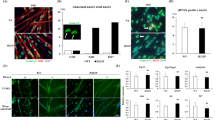Summary
Duchenne muscular dystrophy (DMD) is a lethal sex-linked degenerative disorder of the muscle in man. Generalized cell membrane abnormalities seem to be involved in the pathogenesis of the disease; in particular, the impairment of lymphocyte capping capacities has been repeatedly confimed. To clarify whether capping impairment is a consequence of factors related to the activity of the disease or an expression of an intrinsic cellular defect, we have investigated the capping capacities of DMD EBV-transformed cell lines. The results indicate a significant impairment of capping capacity in cultured cell lines, providing evidence for an intrinsic cell deficiency in DMD.
Similar content being viewed by others
References
Burghes AH, Logan C, Hu X, Belfall B, Worton RG, Ray PN (1987) A cDNA clone from the Duchenne/Becker muscular dystrophy gene. Nature 328:434–437
Chelly J, Kaplan JC, Maire P, Gautron S, Kahn A (1988) Transcription of the dystrophin gene in human muscle and non-muscle tissues. Nature 333:858–860
Goldsmith BM, Greumer HD (1987) Systemic membrane defect and the inhibition of lymphocyte capping in Duchenne muscular dystrophy. Clin Chim Acta 164:33–46
Hoffman EP, Brown HR, Kunkel LM (1987a) Dystrophin: the protein product of the Duchenne muscular dystrophy locus. Cell 51:919–928
Hoffman EP, Knudson CM, Campbell KD, Kunkel LM (1987b) Subcellular fractionation of dystrophin to the triads of skeletal muscle. Nature 330:754–758
Horenstein AL, Emery AEH (1980) Human lymphocyte capping in Duchenne muscular dystrophy. Neurology 30:1330–1332
Koenig M, Hoffman EP, Bertelson CJ, Monaco AP, Feener C, Kunkel LM (1987) Complete cloning of the Duchenne muscular dystrophy (DMD) cDNA and preliminary genomic organization of the DMD gene in normal and affected individuals. Cell 50:509–517
Monaco AP, Bertelson CJ, Middlesworth W, Collett CA, Aldridge J, Fishbeck KH, Bartlett R, Pericak-Vance MA, Roses AD, Kunkel LM (1985) Detection of deletions spanning the Duchenne muscular dystrophy locus using a tightly linked DNA segment. Nature 316:842–845
Nudel V, Zuk D, Einat P, Zeelon E, Levy Z, Neuman S, Yaffe D (1989) Duchenne muscular dystrophy gene product is not identical in muscle and brain. Nature 337:76–78
Sensi A, Venturoli A, Traniello S, Lucci M, Vullo C, Conighi C, Mattiuz PL, Baricordi OR (1984) Impaired capping capacity of peripheral blood lymphocytes in Duchenne muscular dystrophy. J Med Genet 21:182–185
Sudgen B, Marks W (1977) Clonal transformation of adult human leukocytes by Epstein-Barr virus. J Viros 23:503–508
Verrill HL, Pickard NA, Greumer HD (1977) Diminished cap formation in lymphocytes from patients and carriers of Duchenne muscular dystrophy. Clin Chem 23:2341–2343
Zubrzycka-Gaarn EE, Bulman DE, Karpati G, Burghes AHM, Belfall B, Klamut HJ, Talbot J, Hodges RS, Ray PN, Worton RG (1988) The Duchenne muscular dystrophy gene product is localized in sarcolemma of human skeletal muscle. Nature 333:466–469
Author information
Authors and Affiliations
Rights and permissions
About this article
Cite this article
Baricordi, O.R., Sensi, A., Balboni, A. et al. Impairment of capping in lymphoblastoid cell lines of Duchenne patients indicates an intrinsic cellular defect. Hum Genet 83, 217–219 (1989). https://doi.org/10.1007/BF00285158
Received:
Revised:
Issue Date:
DOI: https://doi.org/10.1007/BF00285158




